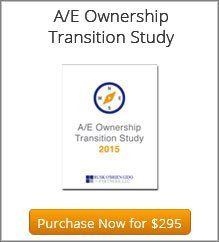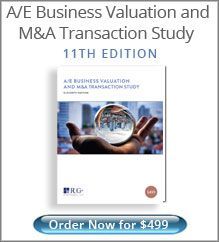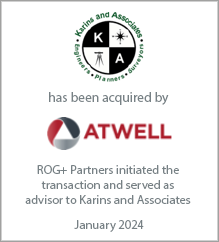Ian has spent the past twenty years working with hundreds of architecture, engineering and environmental consulting firms large and small throughout the U.S. and abroad with a focus on ownership planning, business valuation, ESOP advisory services, mergers & acquisitions, and strategic planning. Ian is a professionally trained and accredited business appraiser and holds the Accredited Senior Appraiser (ASA) designation with the American Society of Appraisers and is a certified merger & acquisition advisor (CM&AA) with the Alliance of Merger & Acquisition Advisors.
The Quest for Reliable Valuation and Financial Performance Statistics
The Quest for Reliable Valuation and Financial Performance Statistics
August 8, 2013
Sportscaster Vin Scully once said about statistics that they should be used like a drunk uses a lamppost, “for support rather than illumination.” But even leaning on statistical data for support can be dangerous if the data is flawed. In the huge and highly fragmented architecture, engineering and environmental consulting industries, owners and managers hunger to know how they are performing relative to their peers, and what their firms are worth. But sturdy and reliable data on peer financial performance and stock valuation can be particularly difficult to find. What’s worse, trying to draw conclusions from imperfect or irrelevant statistical data can be problematic, particularly when trying to place a value on your firm. We hope to remedy this situation soon (read on to learn how), but first a few words of caution on the data sources currently available.
Publicly traded company data
There are a number of publicly traded firms in the industry — AECOM, Stantec, URS and Tetra Tech to name just a few. Because the Securities and Exchange Commission (SEC) requires publicly traded companies to submit regular filings on their financial performance, and because their stocks are traded on open exchanges, a wealth of information can be gleaned with the click of a mouse. There are two major problems with this information however.
The first problem is that these firms are enormous compared to the typical firm in the industry. While the modal firm size in the industry is probably between 10 and 100 employees, publicly traded firms employ thousands of people and generate revenue in the billions of dollars. Because of the vast size difference, using these firms for peer comparison is tricky.
The other major problem relates specifically to stock valuation data. On the one hand, stock pricing data for public firms truly reflects fair market value, as it is based on daily arms-length transactions between willing buyers and willing sellers. However, the stock prices of public firms also reflect their very large size, which capital markets associate with lower risk, and the stock’s liquidity (i.e. the ability to sell the stock almost instantly). These two factors substantially enhance the value of publicly traded firms, all other things being equal.
In other words, just because the average publicly traded firm’s stock is trading at 15x earnings does NOT mean that a much smaller privately held company should also be valued at 15x earnings. Major adjustments must be made to account for size/risk and for the difference in liquidity.
Private merger & acquisition data
Data on actual sales of whole companies is much harder to come by than data on publicly traded stocks. This is because there is no requirement for a privately held firm to disclose the details of a merger or acquisition. Some transaction data can be found if one knows where to look, but that data is often limited and imperfect. Transactions can be structured in a wide variety of ways (asset purchases, stock purchases, statutory mergers) and payment can take many forms (cash, stock of the buyer, notes, earnouts, etc.). It’s often difficult to find information about a private transaction that includes all these details.
Assuming sufficient information can be gathered on private merger & acquisition transactions, it’s very important to understand what this data represents in order to avoid drawing the wrong conclusions. A frequent mistake we see is firm owners using anecdotal data from mergers & acquisitions of peer firms as an indication of how they should price their shares for an internal ownership transition.
The fact that firm XYZ, Inc. was sold to a publicly traded firm last month at a price equal to 80% of its annual net service revenue does NOT mean that you should be pricing your own stock at the same level for internal transactions. The fundamental flaw in this calculus is that the sale of XYZ Inc. represents a controlling interest transaction, while internal ownership transactions typically involve the sale of minority interest ownership stakes. On a per share basis, a block of stock that gives the buyer control over the company is significantly more value than a non-controlling ownership interest.
Surveys of “theoretical” valuations
Industry surveys can be helpful in that they often provide data from samples that are much more representative of the majority of firms in the industry. They also have their weaknesses, however. Such surveys often base valuation data on how the respondents value their stock, rather than on actual arms-length transactions. Therefore they reflect “theoretical” valuations rather than fair market values. Imagine a real estate appraiser estimating the value of a house by walking around and asking neighbors with comparable homes what they think their houses are worth, rather than looking for comparable homes that have actually sold recently.
Surveys that do not distinguish between controlling and non-controlling interests, or other factors such as a respondent firm’s capital structure, or whether or not it holds any non-operating assets such as real estate, can also lead to skewed and unreliable data.
So what’s an owner (or appraiser) to do?
As appraisers, we always look to multiple sources of data and “triangulate” in order to develop a reliable estimate of value. We also make sure to understand what the data we are using represents, and make adjustments accordingly.
Still, it would be great to have a reliable source of appropriately detailed, transaction-based data on the stock values of privately held companies. To this end, we are happy to announce the creation of the A/E Business Valuation and M&A Transaction Study. Over the coming months we will be compiling this study using a confidential on-line survey. The compiled data will include financial performance benchmarking data, valuation multiples for internal (minority interest) stock transactions, ESOP transactions, and merger/acquisition transactions. M&A data will include pricing data as well as data on transaction structures.
As professional business appraisers, we’ve worked carefully to construct a survey that is brief and easy to complete, yet captures enough data to compile a meaningful study.
We plan to supplement the data gathered through this questionnaire with data compiled from public sources. The results of the study will be presented in a form that will allow the user to benchmark their firm’s financial performance and condition, as well as the value of their firm (or an acquisition target) under a variety of circumstances.
Publicly traded company data
There are a number of publicly traded firms in the industry — AECOM, Stantec, URS and Tetra Tech to name just a few. Because the Securities and Exchange Commission (SEC) requires publicly traded companies to submit regular filings on their financial performance, and because their stocks are traded on open exchanges, a wealth of information can be gleaned with the click of a mouse. There are two major problems with this information however.
The first problem is that these firms are enormous compared to the typical firm in the industry. While the modal firm size in the industry is probably between 10 and 100 employees, publicly traded firms employ thousands of people and generate revenue in the billions of dollars. Because of the vast size difference, using these firms for peer comparison is tricky.
The other major problem relates specifically to stock valuation data. On the one hand, stock pricing data for public firms truly reflects fair market value, as it is based on daily arms-length transactions between willing buyers and willing sellers. However, the stock prices of public firms also reflect their very large size, which capital markets associate with lower risk, and the stock’s liquidity (i.e. the ability to sell the stock almost instantly). These two factors substantially enhance the value of publicly traded firms, all other things being equal.
In other words, just because the average publicly traded firm’s stock is trading at 15x earnings does NOT mean that a much smaller privately held company should also be valued at 15x earnings. Major adjustments must be made to account for size/risk and for the difference in liquidity.
Private merger & acquisition data
Data on actual sales of whole companies is much harder to come by than data on publicly traded stocks. This is because there is no requirement for a privately held firm to disclose the details of a merger or acquisition. Some transaction data can be found if one knows where to look, but that data is often limited and imperfect. Transactions can be structured in a wide variety of ways (asset purchases, stock purchases, statutory mergers) and payment can take many forms (cash, stock of the buyer, notes, earnouts, etc.). It’s often difficult to find information about a private transaction that includes all these details.
Assuming sufficient information can be gathered on private merger & acquisition transactions, it’s very important to understand what this data represents in order to avoid drawing the wrong conclusions. A frequent mistake we see is firm owners using anecdotal data from mergers & acquisitions of peer firms as an indication of how they should price their shares for an internal ownership transition.
The fact that firm XYZ, Inc. was sold to a publicly traded firm last month at a price equal to 80% of its annual net service revenue does NOT mean that you should be pricing your own stock at the same level for internal transactions. The fundamental flaw in this calculus is that the sale of XYZ Inc. represents a controlling interest transaction, while internal ownership transactions typically involve the sale of minority interest ownership stakes. On a per share basis, a block of stock that gives the buyer control over the company is significantly more value than a non-controlling ownership interest.
Surveys of “theoretical” valuations
Industry surveys can be helpful in that they often provide data from samples that are much more representative of the majority of firms in the industry. They also have their weaknesses, however. Such surveys often base valuation data on how the respondents value their stock, rather than on actual arms-length transactions. Therefore they reflect “theoretical” valuations rather than fair market values. Imagine a real estate appraiser estimating the value of a house by walking around and asking neighbors with comparable homes what they think their houses are worth, rather than looking for comparable homes that have actually sold recently.
Surveys that do not distinguish between controlling and non-controlling interests, or other factors such as a respondent firm’s capital structure, or whether or not it holds any non-operating assets such as real estate, can also lead to skewed and unreliable data.
So what’s an owner (or appraiser) to do?
As appraisers, we always look to multiple sources of data and “triangulate” in order to develop a reliable estimate of value. We also make sure to understand what the data we are using represents, and make adjustments accordingly.
Still, it would be great to have a reliable source of appropriately detailed, transaction-based data on the stock values of privately held companies. To this end, we are happy to announce the creation of the A/E Business Valuation and M&A Transaction Study. Over the coming months we will be compiling this study using a confidential on-line survey. The compiled data will include financial performance benchmarking data, valuation multiples for internal (minority interest) stock transactions, ESOP transactions, and merger/acquisition transactions. M&A data will include pricing data as well as data on transaction structures.
As professional business appraisers, we’ve worked carefully to construct a survey that is brief and easy to complete, yet captures enough data to compile a meaningful study.
We plan to supplement the data gathered through this questionnaire with data compiled from public sources. The results of the study will be presented in a form that will allow the user to benchmark their firm’s financial performance and condition, as well as the value of their firm (or an acquisition target) under a variety of circumstances.
Latest Perspective
Perfecting the A/E Exit Strategy – Five Key Factors
An enormous A/E generation that kicked off their careers in the 1980s and subsequently started firms or became owners in the 1990s ...
© 2024
Rusk O'Brien Gido + Partners, LLC
Financial Experts for Architects, Engineers, and Environmental Consulting Firms









